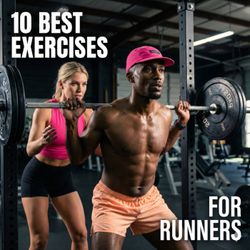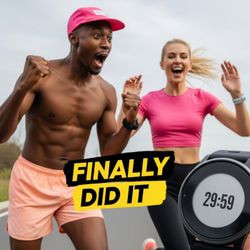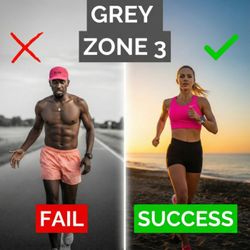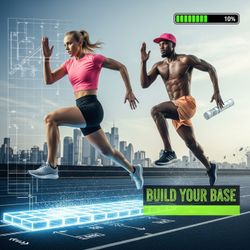Share

The 1% Better Runner with DLake
Helping self-coached runners improve 1% daily with habits that fuel success in life
Latest episode

Why Most Runners Lift Wrong (And How to Fix It)
26:56|Strength training isn’t extra work. It’s the hidden shortcut that finally stops your legs from fading in the last miles.If you have been skipping the gym because you think it takes too much time or will make you too bulky to run fast, this episode flips that script completely. I am breaking down a specific strength training formula that boosts running economy by 5%—that is like shaving minutes off your marathon time without running a single extra mile. You will discover why heavy weights and long rests are actually better for endurance than high reps, and I will walk you through a simple, scalable plan that fits into just 15 to 30 minutes a week so you can finally get stronger, faster, and injury-proof without burning out.Key TakeawaysStrength training for runners isn’t about building big muscles—it’s about teaching your body to run more efficiently and with less risk of injury using just 20–40 minutes a week of targeted lifts.Heavy weights, low reps (4–6), and explosive follow-up moves like jumps help your nervous system recruit muscle faster, which translates to better speed and endurance on the run.Focusing on your posterior chain—glutes, hamstrings, and calves—is the secret to staying strong in the final miles, not just your quads or core.Timestamps[00:25] What You'll Learn[01:17] What Is Strength Training for Running?[01:54] Why Low Reps = Less Fatigue[03:50] Get the Free Training Plan to Do This Yourself[05:06] The Top 10 Best Running Strength Exercises - #1 Squat[06:48] Romanian Deadlifts (RDLs)[08:06] Bulgarian Split Squat[09:06] Step-Ups[10:15] Help Another Runner Do More Smarter Strength Training[11:01] Calf Raises[14:04] Drop Jumps[15:12] I Tried Them and It Hurt[16:01] Squat Jumps[16:33] Single-Leg Bounds (Forward or Up)[17:19] The Load-Explode Protocol[18:00] Which Muscles Power Your Running[18:17] Backup Muscles for Running[19:59] S.H.E. (Slow, Hold, Explode) Method Explained[20:32] Putting It All Together[22:43] The 4 Golden Rules[23:58] How This Scales to Your Time Commitment[26:23] Beginners Do This for Strength Advanced to This for Muscle GainLinks & Learnings📈 Get Strong & Run Fast In Less Time (Free Training Plan): https://dlakecreates.com/strengthfree🎧 Listen, read and learn more here: https://dlakecreates.com/strengthbestNew To Strength Training? Start Here: https://dlakecreates.com/10w2s-5How To Gain Muscle & Run A lot: https://dlakecreates.com/gainmuscleInstagram: https://instagram.com/dlakecreatesStrava: https://www.strava.com/athletes/120507
More episodes
View all episodes

You’ll Never Break a 30 Minute 5k Training Like This
27:31|Breaking 30 minutes in the 5K isn’t about trying harder; it’s about finally training the right engine.In this episode, I break down exactly why the common three-day training plan often fails the biology of a 5K and how shifting your schedule unlocks the specific aerobic engine required for speed. I walk you through the exact physiological systems you need to target, the specific pacing strategy that prevents the dreaded mid-race burnout, and the essential strength moves that keep you healthy enough to finally crush your goal time.Key TakeawaysA sub-30 5K is mostly an aerobic challenge, and building the right engine matters more than just pushing harder.Switching from three days of running to a four-day structure changes everything because it finally creates the volume and balance needed for real progress.Clear pacing, smart workouts, and simple recovery habits work together to prevent blow-ups and help you stay strong through the final third of the race.Timestamps[00:43] What You'll Learn[01:42] The Problem: Why You're Stuck at 30:15[03:59] The Training Split That Actually Works[06:57] Sample Four-Day Sub 30 Min 5k Training Week[08:14] Get the Free Training Plan[09:08] Run Training — VO2 Max, Speed Intervals, Threshold Work Long Run[10:37] VO2 Max Work[13:44] Lactate Threshold Work[14:53] Long Run[15:32] Race Pacing Strategy: The Game Plan[19:32] Do This to Help Another Runner Go Sub 30 Minutes[19:54] 5 Best Bodyweight Strength Exercises for Runners[23:16] Recovery and Nutrition Hydration[25:37] Mental/Belief Shift: Why Sub-30 Is Actually Possible[26:38] Use This to Fix Your Run FormLinks & Learnings📈 Get your free Run sub 30 min 5k Training Plan here https://dlakecreates.com/5ksub30free🎧 Listen, read and learn more here https://dlakecreates.com/5ksub30Run Longer & Farther with this - https://dlakecreates.com/baseThe best cross-training activities for runners ranked - https://dlakecreates.com/run-specific-cross-training-guide/Learn how to use VDOT calculator for race paces - https://dlakecreates.com/using-vdot-calculator-for-runners/Threshold Explain + Find Your Threshold Run Pace - https://dlakecreates.com/lactate-threshold-training/The 5 Best Body weight only Strength workouts - https://dlakecreates.com/10w2s-5Why Recovery Is More Important Than Training - https://dlakecreates.com/recoveryGet 6 magical tips to perfect running form - https://dlakecreates.com/runformInstagram – https://instagram.com/dlakecreatesStrava – https://www.strava.com/athletes/120507
Your Super Shoes Are Lying to You (Here’s How)
10:46|What if the very shoes designed to protect you are actually making you more prone to injury?If you’ve ever wondered why your feet still hurt even though you keep buying softer shoes, this episode breaks it all down. I dig into what heavy cushioning actually does to your body, why variety matters more than any single “perfect” shoe, and how foot strength changes the way you run. You’ll hear the simple steps I use to build tougher, more responsive feet, plus how to choose and rotate shoes so your body gets stronger instead of overloaded. If you’ve been stuck in the cycle of soreness, this might be the reset your running needs.Key TakeawaysMax-cushion shoes might feel comfortable, but they can weaken your feet over time by reducing natural shock absorption and muscle engagement.Running in the same shoe every day creates repetitive stress—rotating between different types of shoes helps build strength and prevent injury.Your feet need feedback from the ground to stay strong and stable; too much cushion dulls that connection and can hurt your form.Timestamps[00:58] The Run Shoe Industry Story[01:36] The Science Behind Super Shoes[03:14] What's The Real Problem?[04:21] Use This To Get Strong Feet[04:56] Why Feet Matter More Than Shoes[05:40] Train Your Feet - Step 1: Stop Wearing One Shoe for Everything[07:32] Step 2: Build Foot Strength Progressively[08:34] Step 3: Use Max Cushion Strategically, Not Exclusively[09:07] Step 4: Pay Attention to Ground Feel[10:00] Understand This About Gear and You'll Actually Run Faster FartherLinks & Learnings📈 Get your free 3 Shoe Rotation Cheat Sheet & Training Plan: https://dlakecreates.com/shoerotationfree🎧 Listen, read and learn more here: https://dlakecreates.com/shoecushionStop Wasting Money on the Wrong Gear - https://dlakecreates.com/gearInstagram – https://instagram.com/dlakecreatesStrava – https://www.strava.com/athletes/120507
You’re Running in the WRONG ZONE (And It’s Slowing You Down) | Gray Zone 3
10:13|The single biggest mistake runners make isn't about shoes, diet, or mileage. It's running every single day in the one zone that guarantees burnout.What if everything you thought about "moderate effort" running was backwards? Most runners are confused about the grey zone because it feels productive but rarely delivers results. In this episode, I break down what the grey zone actually is, why it leaves so many people feeling stuck, and how to tell when it’s helping versus hurting your training. I walk through simple ways to spot it, explain why it’s often called “junk” work, and show how to use it intentionally without burning yourself out. If you want to feel fresher, train smarter, and finally understand where your effort should go, this episode gives you the clarity to do that.Key TakeawaysThe grey zone is not a bad pace by itself, but it becomes a problem when it turns into your default for every run. When that happens, you stay tired without getting fitter.Easy runs should feel truly easy, and hard days should feel clearly hard. The progress comes from separating those efforts instead of living in the middle.Grey zone works best when it’s used on purpose for specific goals like marathon pace or tempo work. It should support your training, not quietly take it over.Timestamps[00:24] What You'll Learn[01:10] What Is It and How to Spot The Grey Zone[03:43] Why People Call It Junk and Why That’s Wrong[05:38] How To Use The Grey Zone In a Smart Way[06:22] Use This to Run In The Grey Zone[06:43] When To Use (And Avoid) Grey Zone[08:27] Check If You're In The Grey Zone[09:36] Use This To Build Your Base Before Building Your Grey ZoneLinks & Learnings📈 Get your free avoid the grey zone training plan here https://dlakecreates.com/subthresholdfree🎧 Listen, read and learn more here https://dlakecreates.com/grayzonesimpleLearn more about the Grey Zone here - https://dlakecreates.com/greyzoneRun far and longer with ease here - https://dlakecreates.com/baseInstagram – https://instagram.com/dlakecreatesStrava – https://www.strava.com/athletes/120507
Everyone’s Wrong About Runner’s Knee—Here’s Proof
07:18|What if the very activity you've been warned against is actually the best thing you can do for your knee health?If you’ve ever been told running will ruin your knees, this episode is going to flip that idea on its head. I break down why so many people blame the wrong thing for their pain, what the science actually says about how knees adapt, and the real habits that cause most runners to struggle. You’ll learn the simple changes that protect your joints, help you recover better, and make your runs feel smoother and stronger over time. By the end, you’ll know exactly how to train in a way your body can handle—without guessing, overthinking, or falling into the traps that keep runners stuck.Key TakeawaysRunning isn't the problem for your knees; in fact, it helps strengthen them. The real issue comes from doing too much too soon and not allowing your body to recover properly.You can protect your knees by slowly increasing your mileage and making your easy runs truly easy. Varying your runs, your shoes, and your surfaces also helps prevent repetitive stress.Strong muscles support your knees, so strength training your glutes, hips, and quads is crucial. This helps your body handle impact so your knees don't have to take the full force.Timestamps[00:31] The Amateur Knee Experts[01:26] Why is Sitting Worse For Your Knees Than Running?[02:40] Joints Are Built to Move, Not Sit[03:02] How To Run Without Hurting Your Knees[04:16] What Actually Protects Your Knees[05:16] Use This To Run Farther & Longer[05:43] Protect Your Knees By Training your posterior chain[06:35] Do This Thing In The Off-Season To Protect Your Knees Even FurtherLinks & Learnings📈 Get your free run far and long with less effort training plan https://dlakecreates.com/basefree🎧 Listen, read and learn more here https://dlakecreates.com/badforkneesHow to run far and long with less effort (base training) https://dlakecreates.com/base2Prevent & Fix your Runner’s Knee issue with this - https://dlakecreates.com/runnerskneeInstagram – https://instagram.com/dlakecreatesStrava – https://www.strava.com/athletes/120507
Why You Get Tired So Fast (And How to Fix It Instantly)
21:55|The single biggest mistake runners make is trying to run fast on every single run, and it’s the very thing that’s holding you back from your next personal best.If you’ve ever wondered why you blow up halfway through long runs or can’t seem to get faster no matter how hard you push, this episode breaks down the real reason: your base isn’t strong enough. I dig into what base training actually is, why it matters more than most people realize, and how it quietly transforms your speed, endurance, and resilience. You’ll learn how to structure your easy runs, how the long run fits in, and how to use simple strength, stride, and plyometric work to build a body that can handle real training. By the end, you’ll know exactly how to start doing this in your own running without feeling overwhelmed.Key TakeawaysSlowing down builds the aerobic engine that makes long-distance running feel easier and faster. When most runs stay easy, your body adapts in powerful ways.A strong base protects you from injuries by giving your muscles, tendons, and joints time to catch up to your cardio. Training gets more enjoyable when you’re not constantly drained or hurting.When the engine is built, speed work finally works the way it should. You can run faster with less effort because your foundation can actually support it.Timestamps[00:33] What You'll Learn[01:21] What Is Base Training?[05:15] Use This to Run Far Long with Ease Right Now[06:34] The Actual Base Training Plan - Pillar 1: Easy Running[08:14] Pillar 2: Long Run (1x Per Week)[09:25] Pillar 3: Build The Chassis and Run Economy: Strength, Plyos, Strides Drills[14:50] Why You Should Not Skip Base Training[17:06] How Long Do You Need When Are You Ready to Do Faster Work?[19:58] Base Training Misconceptions[21:14] Why You Really Need to Learn About Long Runs After BaseLinks & Learnings📈 Get your free run farther and faster base training plan https://dlakecreates.com/basefree🎧 Listen, read and learn more here https://dlakecreates.com/base2Learn all about strides - https://dlakecreates.com/strideswithmeLearn all about long run - https://dlakecreates.com/longrunLearn all about A-Skips - https://dlakecreates.com/askipsGet the 5 body weight only Strength moves you’ll ever need as a runner - https://dlakecreates.com/10w2s-5Instagram – https://instagram.com/dlakecreatesStrava – https://www.strava.com/athletes/120507
Why You Don’t Need to Choose Between Strength and Running
19:36|What if the thing holding back your running is your fear of lifting weights?If you’ve ever felt torn between running and lifting, this episode shows you how to build both without choosing sides. I walk through what hybrid training really is, why it’s blowing up, and how to make it work even if you’re brand new. You’ll learn the mistakes that keep runners weak, the habits that hold lifters back, and the simple weekly structure that helps anyone get stronger, faster, and fitter at the same time. It’s a clear roadmap for training smarter so your body can finally do more without falling apart.Key TakeawaysYou don't have to choose between running and lifting. Combining them builds a fitness level that helps you perform better in sports and everyday life.If you are a runner, strength training makes you more efficient. This means you can run the same pace while using less energy.If you are a lifter, learning to run at an easy, conversational pace builds your cardio without hurting your strength gains.Timestamps[00:30] What You'll Learn[01:16] What is Hyrox[03:00] The Fork in the Road: Runner vs Lifter[03:29] Use This to Become a Hybrid Athlete[03:46] For Runners—How to Train Like a Gym Bro (Without Becoming One)[07:00] Functional Lower Body Work[08:26] Use This to Schedule Your Running Lifting Perfectly[09:03] For Lifters—How to Run Like a Hybrid Athlete (Not a Broken Bro)[12:38] Run Economy Basics for Big Humans[15:50] A Simple Hybrid Week Plan[18:46] Use This to Run a Faster HYROXLinks & Learnings📈 Get your free hybrid athlete/hyrox training plan here https://dlakecreates.com/hyroxfree🎧 Listen, read and learn more here https://dlakecreates.com/hyroxLearn how to run far and fast easier - https://dlakecreates.com/baseLearn the top 5 body weight strength exercises for runners - https://dlakecreates.com/10w2s-5Instagram – https://instagram.com/dlakecreatesStrava – https://www.strava.com/athletes/120507